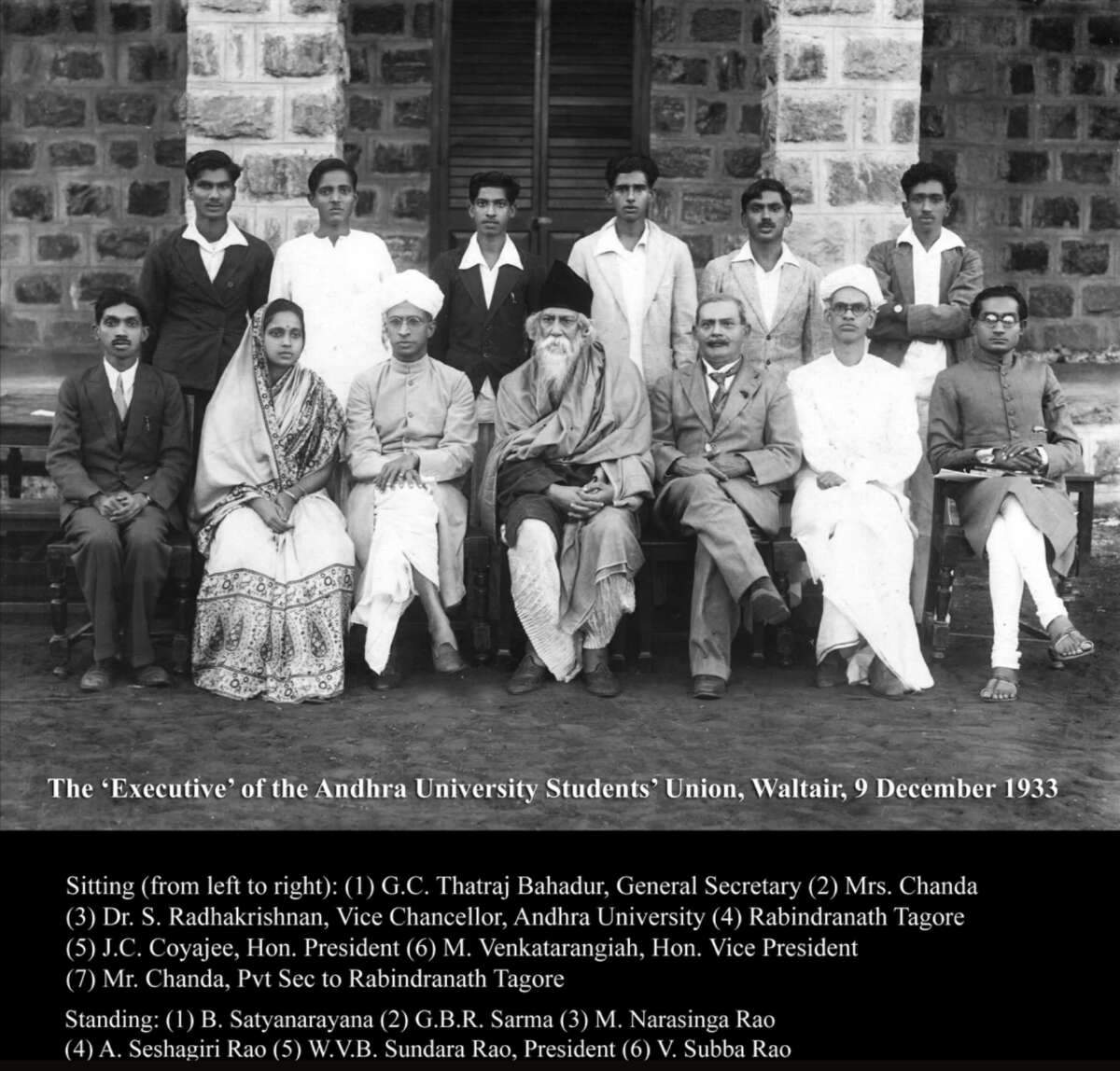For one born in Vizag or any Telugu city, there comes a time after primary and secondary schooling when they must choose where to spend their university years. Inevitably, Andhra University is almost always a part of this conversation. And why not? With a campus spread over 422 acres, grand buildings that pre-date India’s independence, and an estimable reputation, Andhra University would be a seal of accomplishment on anyone’s resume! In fact, it is a matter of great pride that many a notable personality has passed through or been involved with this institution in some way – M Venkiah Naidu (former Vice President of India), Sarvepalli Radhakrishnan (former President of India), CV Raman (Indian physicist), Duvvuri Subba Rao (former Governor Reserve Bank of India), and more! Today, the prestigious Andhra University completes ninety-nine years and stands on the cusp of hitting a century! John Castellas, a Vizag history and heritage enthusiast, takes us back to its revolutionary beginnings and sheds light on how this seat of education took shape:
Andhra University approaches its centenary on 26 April 2026, when the university staff and alma mater will proudly celebrate 100 years of academic excellence.
As early as 1913, the Telugu people had demanded a separate university. The Union of India Act in 1919 guaranteed autonomy for regions in matters of education and in December 1920, the first Minister for Education in Madras Presidency, Subbarayalu Reddiar, was appointed. In 1921, the Government of Madras appointed a committee to consider the establishment of a separate Andhra University. The Andhra University Act came into force in April 1926.

The creation of the Andhra University was one of the remarkable deeds done by the Justice Government during its short tenure of office. With the establishment of the University of Mysore in 1916 and the Osmania University (Hyderabad) in 1918, the tempo of demand for Andhra University had increased. The Andhra University was started at Bezwada (Vijaywada) on 26th April 1926 with jurisdiction over all the Telugu districts. The headquarters of the university was to be Bezwada, with university centres at Rajamundry (Rajahmundry), Vizagapatam (Visakhapatnam), and Anantapur (Ananthapuramu).
There was considerable controversy regarding the final location of the headquarters. Twenty of the thirty-three members of the Select Committee on the Andhra University Bill wrote dissenting minutes advocating different towns and it took nearly three years to choose the place where the university would finally be located.
At last in 1929 due to the earnest efforts of the founding Vice Chancellor, Sir C R (Cattamanchi Ramalinga) Reddy, Vizag was chosen as the venue of this great temple of learning. This was the first university in the whole of the Indian sub-continent started in the name of a linguistic group. It is also regarded as the first university which provided for the use of Indian languages such as Telugu, Kannada, Urdu and Oriya as the medium of instruction and examination.
The 99-year-old institution was fortunate to have Sir C R Reddy as its founder Vice-Chancellor, as the steps taken by this visionary proved to be fruitful in the long run. Former President of India Dr Sarvepalli Radhakrishnan succeeded Dr C R Reddy in 1931 as Vice-Chancellor. He acted promptly at the first meeting of the syndicate a fortnight after taking charge and secured the appointment of temporary staff in English, Telugu, French and History. The university’s College of Arts was inaugurated on 1 July 1931. The inaugural courses were Telugu Language and Literature, History, Economics and Politics. A year later, on 4 July 1932, the College of Science and Technology came into being with Honours courses in Physics and Chemistry.
As there were no buildings, the College of Arts classes were started in Bobbili Hall (current Grand Bay Hotel) in Waltair, which was put at the university’s disposal by the Maharajah of Bobbili, its Pro-Chancellor. Rooms for the students were reserved in the hostels of other local colleges. The offices of the university were in a mansion in Waltair, and the College of Science was on the ground floor of the Cecil Hotel while Panchavathi became the Vice-Chancellor’s residence.

In 1931, within days of assuming office, Vice-Chancellor Radhakrishnan acquired for the university about fifty-four acres in the Waltair Upland areas, appointed architect LM Chitale of Madras to draw plans for the colleges of arts and of science and three hostels, called for tenders, selected the construction firm “Britannia Building & Iron” of Calcutta in consultation with the chief engineers of Madras and Bengal, and saw to it that work began.
The site of the building provided magnificent views of Dolphin’s Nose to the South West and the Bay of Bengal to the South East. The campus layout was along the central axis of the Science & Technology College. A clock-tower was central to the science college above the main staircase and an observatory was planned for the Arts College above the central staircase. Three hostels, each of three levels, accommodated 130 students in single, well-ventilated rooms. The buildings were constructed of a local red-tinted stone.
The college buildings were progressively readied for use: Arts by 1933, Science by 1934 and the 3 hostels by 1935 and, by the time of Radhakrishnan’s departure in 1936, the construction of the library and the clock tower had been completed. These buildings remain as a testament to the Art Deco-style architectural heritage of Vizag and the work of one of India’s most accomplished architects.

First Buildings of Andhra University (Right)
Funding from the Madras Government for the new buildings at Waltair was scarce because of the recession that prevailed at the time. The Vice-Chancellor, Radhakrishnan, turned to wealthy Zamindars and publicly minded wealthy friends for donations. The Rajahs of Bobbili, Panagal, and Pittapuram, along with the Maharajahs of Vizianagram and Travancore were major contributors. Radhakrishnan also secured the assent of the Maharajah of Jeypore, who had literary and philosophical interests, to provide a lakh of rupees every year for the College of Science till such time as the capital sum amounted to fifteen lakh rupees.

Sir Vikrama Deo Verma, the Maharajah of Jeypore became the University Pro-Chancellor in 1936 and the Science college was later renamed the Jeypore Vikrama Deo College of Science & Technology. A statue of the great benefactor now rises majestically in front of the college.

The Andhra University staff were encouraged to give extension lectures in Waltair as well as in other Andhra towns. Vice Chancellor Radhakrishnan also persuaded his friend, Alladi Krishnaswami, to endow a series of lectures to be given in Waltair by eminent Indians. Radhakrishnan set his sights high. Mahatma Gandhi was invited but could not come; but Rabindranath Tagore did, to deliver the Alladi Krishnaswamy lectures in December 1933 and again in 1934.
The citizens of Vizag will join the staff and alma mater of Andhra University and be justifiably proud on 26 April 2026, when their esteemed academic institution celebrates its centenary year!
Written by John Castellas whose family belonged to Vizag for 5 generations. Educated at St Aloysius, migrated to Melbourne, Australia in 1966, former General Manager Engineering at Boeing & Qantas Airways, in retirement lectured in Aviation Management at Swinburne University and is a Vizag aficionado. He can be contacted be at jcastell@ozemail.com.au
Stay tuned to Yo! Vizag website and Instagram for more heritage.










Discussion about this post